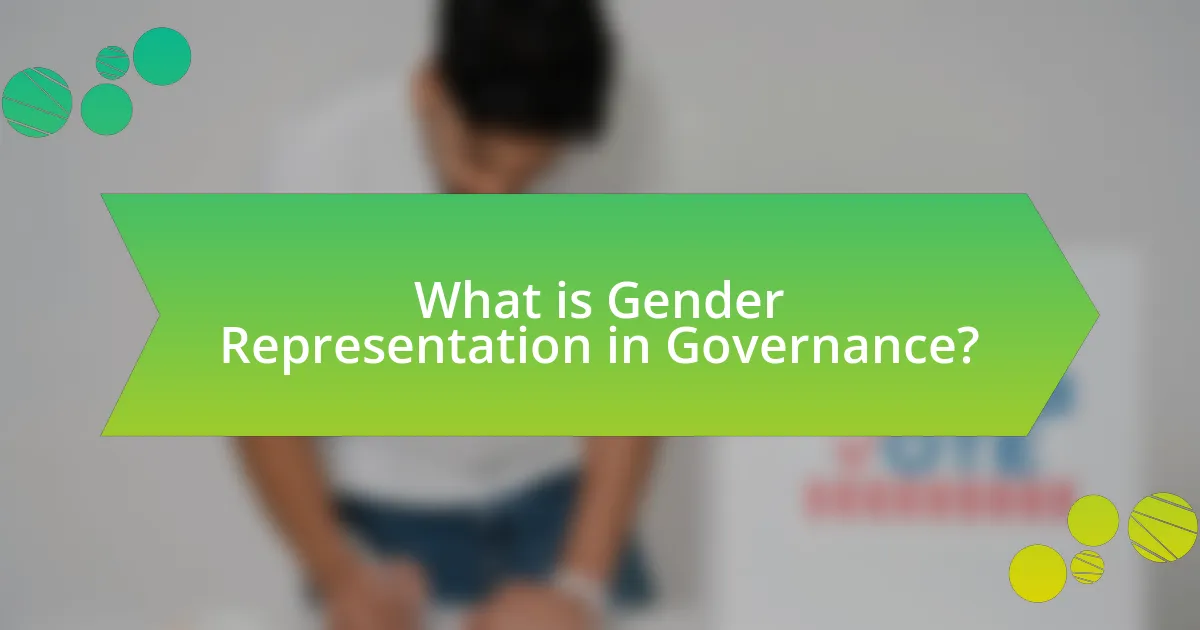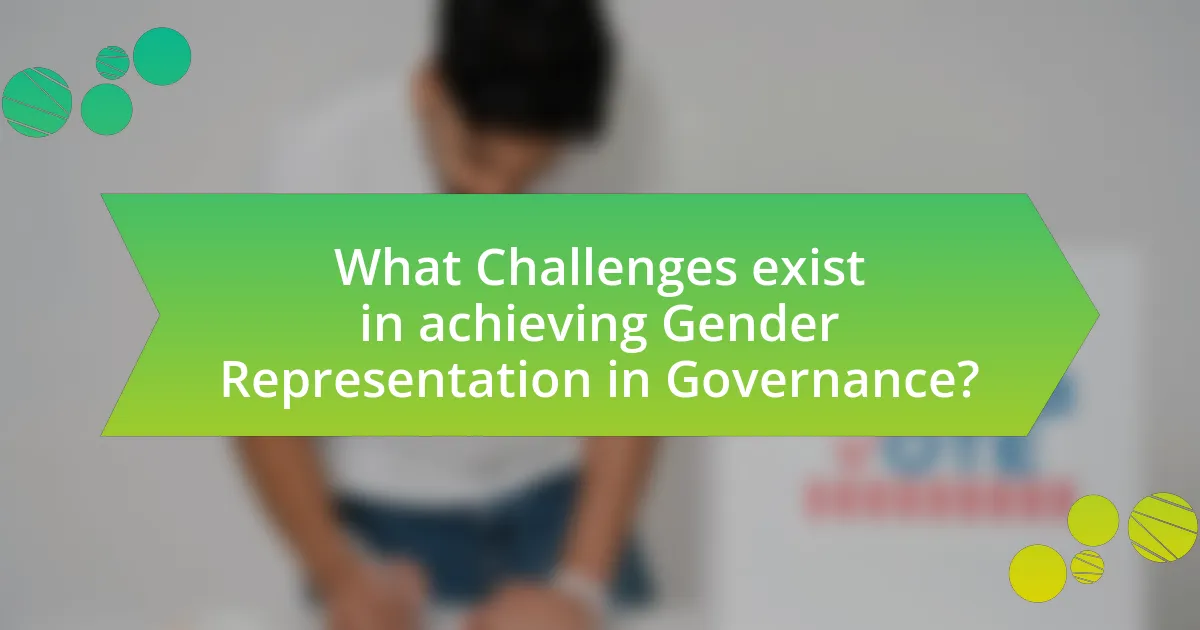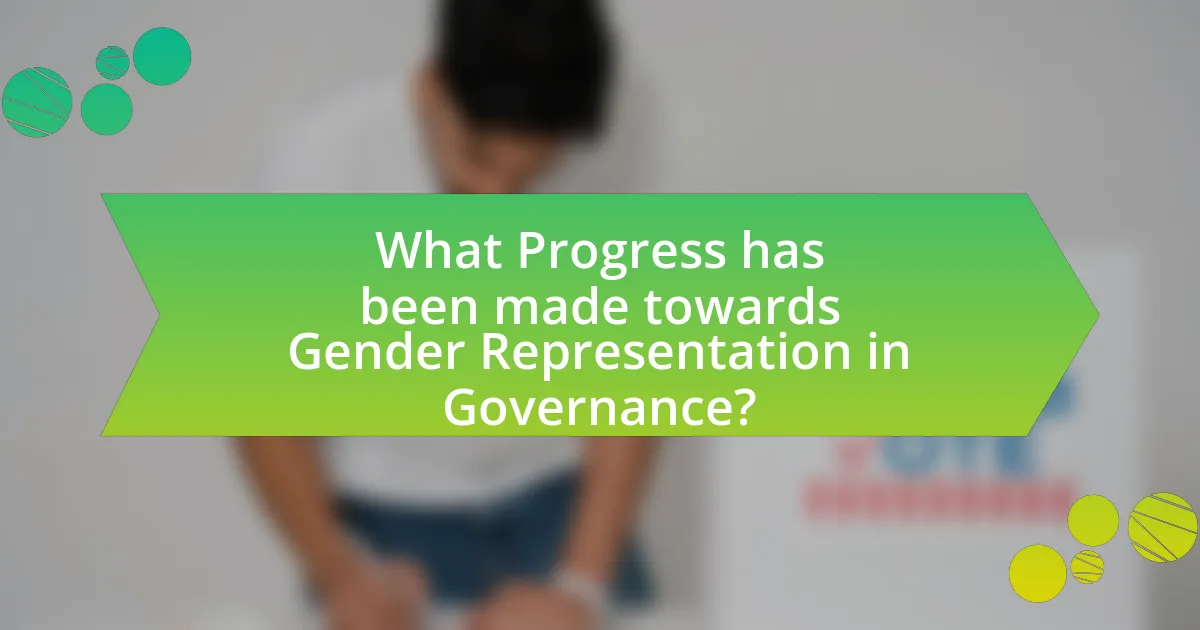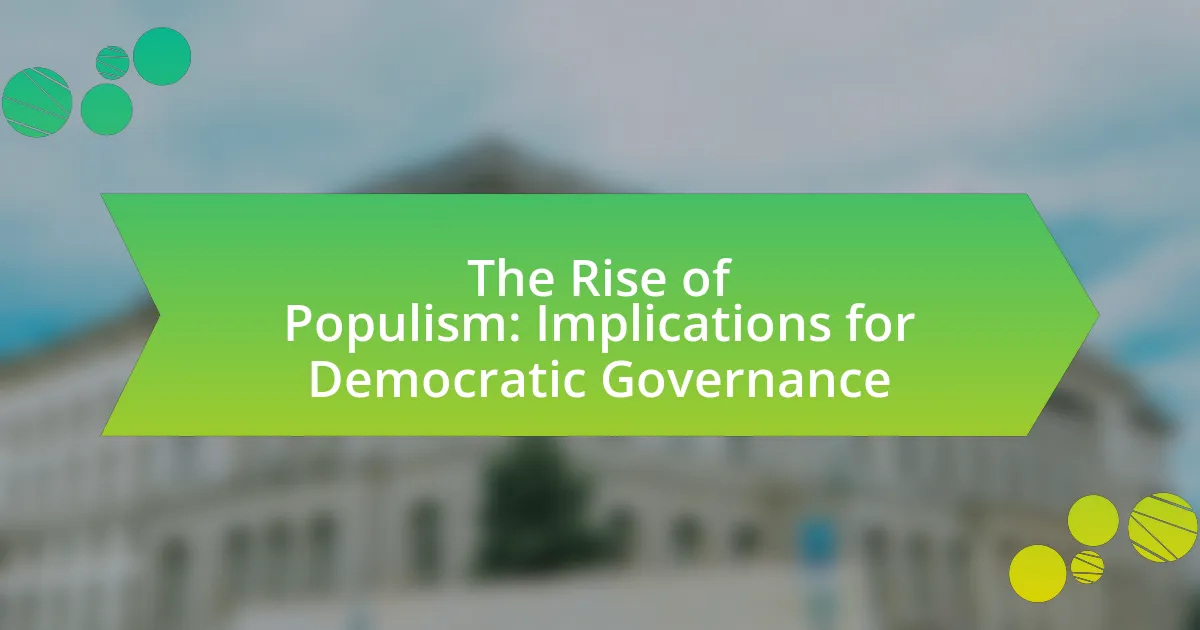Gender representation in governance refers to the equitable involvement of individuals of various genders in decision-making and leadership roles within political structures. This article examines the significance of gender representation, highlighting its impact on policy-making and social outcomes, as well as the historical context of women’s participation in governance. It discusses current trends, challenges, and barriers to achieving gender parity, including systemic discrimination and cultural norms. Additionally, the article explores successful initiatives and best practices that have improved gender representation, while also considering the future prospects and the role of technology and education in fostering inclusive governance.

What is Gender Representation in Governance?
Gender representation in governance refers to the equitable participation of individuals of different genders in decision-making processes and leadership roles within political and governmental structures. This concept emphasizes the importance of including women and marginalized genders in governance to ensure diverse perspectives and equitable policy-making. Research indicates that countries with higher levels of gender representation in governance tend to experience improved social and economic outcomes, such as enhanced governance quality and increased public trust. For instance, a study by the Inter-Parliamentary Union found that as of 2021, countries with at least 30% women in parliament reported better legislative outcomes related to health and education.
Why is Gender Representation important in Governance?
Gender representation is important in governance because it ensures that diverse perspectives and experiences are included in decision-making processes. When women and marginalized genders participate in governance, policies are more likely to address the needs of the entire population, leading to more equitable and effective outcomes. Research shows that countries with higher levels of gender representation in political leadership tend to have better social and economic indicators, such as improved health care and education systems. For instance, a study by the Inter-Parliamentary Union found that countries with at least 30% women in parliament experience a 15% increase in the likelihood of passing legislation that benefits women and children. This evidence underscores the critical role of gender representation in fostering inclusive governance and promoting social justice.
What are the historical contexts of Gender Representation in Governance?
Gender representation in governance has evolved significantly over time, influenced by social, political, and economic changes. Historically, women’s participation in governance was largely restricted; for instance, in many societies, women were denied the right to vote or hold office until the 20th century. The suffrage movement, particularly in the early 1900s, marked a pivotal moment, with countries like New Zealand granting women the right to vote in 1893, followed by others such as the United States in 1920 and the United Kingdom in 1928.
The post-World War II era saw a gradual increase in women’s representation, spurred by global movements for gender equality and the establishment of international frameworks like the United Nations’ Convention on the Elimination of All Forms of Discrimination Against Women (CEDAW) in 1979. This period highlighted the importance of women’s voices in governance, leading to policies aimed at increasing female participation.
By the late 20th and early 21st centuries, many countries implemented quotas and affirmative action policies to enhance gender representation in political offices. For example, Rwanda achieved remarkable representation, with women holding over 60% of parliamentary seats since 2008, largely due to constitutional mandates for gender parity.
These historical contexts illustrate the ongoing struggle for gender representation in governance, shaped by activism, legal reforms, and societal shifts towards inclusivity.
How does Gender Representation impact decision-making processes?
Gender representation significantly impacts decision-making processes by enhancing diversity and inclusivity, which leads to more comprehensive and effective outcomes. Research indicates that organizations with higher gender diversity in leadership roles tend to make better decisions, as diverse teams are more likely to consider a wider range of perspectives and solutions. For instance, a study by McKinsey & Company found that companies in the top quartile for gender diversity on executive teams were 21% more likely to experience above-average profitability compared to those in the bottom quartile. This correlation suggests that gender representation not only fosters equitable governance but also drives better performance and innovation in decision-making.
What are the current trends in Gender Representation in Governance?
Current trends in gender representation in governance indicate a gradual increase in women’s participation in political leadership roles globally. As of 2023, women hold approximately 26% of parliamentary seats worldwide, reflecting a steady rise from previous years, according to the Inter-Parliamentary Union. Additionally, more countries are implementing gender quotas to enhance female representation, with over 130 nations adopting such measures. This trend is supported by research from the World Economic Forum, which highlights that gender-diverse leadership teams lead to improved decision-making and governance outcomes.
How have recent policies influenced Gender Representation?
Recent policies have significantly improved gender representation by implementing quotas and promoting gender equality initiatives. For instance, many countries have adopted gender quotas for political parties, resulting in increased female participation in legislative bodies; for example, Rwanda’s quota system has led to women holding over 60% of parliamentary seats, the highest in the world. Additionally, policies aimed at addressing workplace discrimination and promoting family-friendly workplace practices have further encouraged women’s involvement in governance. These measures collectively contribute to a more balanced representation of genders in decision-making processes.
What statistics reflect the state of Gender Representation globally?
As of 2023, women hold approximately 26.1% of parliamentary seats globally, reflecting a significant underrepresentation in governance. This statistic indicates that despite progress, gender parity in political representation remains elusive, with only 12 countries achieving at least 50% female representation in their national legislatures. Furthermore, the World Economic Forum’s Global Gender Gap Report highlights that it will take an estimated 135.6 years to close the gender gap in political empowerment at the current rate of progress. These figures underscore the ongoing challenges in achieving equitable gender representation in governance worldwide.

What Challenges exist in achieving Gender Representation in Governance?
Achieving gender representation in governance faces several challenges, including systemic barriers, cultural norms, and lack of support mechanisms. Systemic barriers such as discriminatory laws and policies hinder women’s participation in political processes; for instance, only 25% of national parliamentarians globally are women, according to the Inter-Parliamentary Union. Cultural norms often perpetuate stereotypes that discourage women from pursuing leadership roles, leading to underrepresentation in decision-making positions. Additionally, the lack of support mechanisms, such as mentorship programs and funding for female candidates, further exacerbates the issue, making it difficult for women to compete on equal footing with their male counterparts. These challenges collectively impede progress toward achieving gender parity in governance.
What are the barriers to Gender Representation in Governance?
Barriers to gender representation in governance include systemic discrimination, cultural norms, and lack of access to resources. Systemic discrimination manifests in political structures that favor male candidates, often resulting in fewer opportunities for women to participate in governance. Cultural norms frequently dictate traditional gender roles, discouraging women’s involvement in leadership positions. Additionally, women often face barriers in accessing financial resources and networks necessary for political campaigns, which further limits their representation. According to the Inter-Parliamentary Union, as of 2021, women held only 25.5% of parliamentary seats globally, highlighting the persistent underrepresentation and the impact of these barriers.
How do cultural attitudes affect Gender Representation?
Cultural attitudes significantly influence gender representation by shaping societal norms and expectations regarding gender roles. For instance, cultures that prioritize traditional gender roles often limit women’s participation in governance, resulting in lower representation in political positions. Research indicates that in countries with strong patriarchal values, such as Afghanistan, women hold only 27% of parliamentary seats, compared to countries with more egalitarian views, like Sweden, where women occupy 47% of parliamentary positions. These disparities highlight how cultural perceptions directly impact the opportunities available for different genders in governance.
What role do political structures play in hindering Gender Representation?
Political structures significantly hinder gender representation by perpetuating systemic barriers that limit women’s participation in governance. These structures often include electoral systems, party dynamics, and institutional practices that favor male candidates, resulting in underrepresentation of women in decision-making roles. For instance, countries with majoritarian electoral systems tend to have fewer women in parliament compared to those with proportional representation, as the latter allows for more diverse candidate lists. Additionally, political parties frequently prioritize male candidates due to entrenched biases and networks, which further marginalizes women. According to the Inter-Parliamentary Union, as of 2021, only 25% of national parliamentarians worldwide were women, highlighting the persistent gap in gender representation linked to these political structures.
What are the consequences of inadequate Gender Representation?
Inadequate gender representation leads to a lack of diverse perspectives in decision-making processes, which can result in policies that do not address the needs of all segments of the population. Research indicates that organizations with greater gender diversity are 15% more likely to outperform their counterparts, highlighting the importance of varied viewpoints in governance. Furthermore, inadequate representation can perpetuate gender stereotypes and inequalities, as seen in the World Economic Forum’s Global Gender Gap Report, which shows that countries with lower female political representation often have wider gender pay gaps and less access to education for women. This lack of representation ultimately hinders social progress and economic development.
How does lack of representation affect policy outcomes?
Lack of representation significantly skews policy outcomes, often leading to the neglect of issues pertinent to underrepresented groups. For instance, research indicates that when women are underrepresented in legislative bodies, policies related to health, education, and social welfare tend to receive less attention, resulting in inadequate support for these critical areas. A study by the Inter-Parliamentary Union found that countries with higher female representation in parliament are more likely to pass laws promoting gender equality and social welfare, demonstrating that diverse representation directly influences the prioritization of policies that address the needs of all citizens.
What are the social implications of Gender Imbalance in Governance?
Gender imbalance in governance leads to significant social implications, including the perpetuation of inequality and the underrepresentation of diverse perspectives in decision-making processes. This imbalance often results in policies that do not adequately address the needs of all citizens, particularly women and marginalized groups. For instance, research by the Inter-Parliamentary Union indicates that countries with higher female representation in governance tend to have more progressive policies on health, education, and social welfare. Furthermore, gender imbalance can foster a culture of discrimination and reinforce stereotypes, limiting opportunities for women in leadership roles and affecting societal norms regarding gender equality.

What Progress has been made towards Gender Representation in Governance?
Significant progress has been made towards gender representation in governance, evidenced by an increase in the number of women in political leadership roles globally. As of 2023, women hold approximately 26% of parliamentary seats worldwide, a notable rise from 11% in 1995, according to the Inter-Parliamentary Union. Additionally, the number of countries with women serving as heads of state or government has increased, with 15 women in such positions as of 2023, compared to only 5 in 2000. This advancement reflects ongoing efforts to promote gender equality through policies, quotas, and advocacy initiatives aimed at empowering women in political spheres.
What initiatives have successfully improved Gender Representation?
Initiatives that have successfully improved gender representation include gender quotas, mentorship programs, and targeted recruitment strategies. Gender quotas, implemented in various countries such as Rwanda, have led to significant increases in women’s representation in government, with Rwanda achieving over 60% female representation in its lower house of parliament. Mentorship programs, like those offered by organizations such as Lean In, provide women with guidance and support to advance in their careers, contributing to higher representation in leadership roles. Targeted recruitment strategies, employed by companies and institutions, focus on attracting diverse candidates, resulting in improved gender balance in hiring practices. These initiatives demonstrate measurable success in enhancing gender representation across different sectors.
How have grassroots movements contributed to Gender Representation?
Grassroots movements have significantly enhanced gender representation by mobilizing communities to advocate for women’s rights and participation in governance. These movements have raised awareness about gender disparities, leading to increased public support for policies that promote women’s representation. For instance, the Women’s March in 2017 galvanized millions globally, emphasizing the need for equal representation and influencing political discourse. Additionally, organizations like the National Organization for Women have worked tirelessly to push for legislative changes, resulting in more women being elected to office. Data from the Inter-Parliamentary Union shows that countries with active grassroots movements have seen a higher percentage of women in legislative roles, demonstrating the direct impact of these movements on gender representation.
What role do international organizations play in promoting Gender Representation?
International organizations play a crucial role in promoting gender representation by establishing frameworks, guidelines, and initiatives that encourage equal participation of women in governance. For instance, the United Nations has implemented various resolutions, such as the 2030 Agenda for Sustainable Development, which includes a commitment to achieving gender equality and empowering all women and girls. Additionally, organizations like the World Bank and the International Monetary Fund provide funding and technical assistance to countries that prioritize gender-inclusive policies. These efforts are supported by data indicating that increased gender representation in governance leads to more equitable and effective decision-making, as evidenced by studies showing that women in leadership roles contribute to improved economic and social outcomes.
What best practices can enhance Gender Representation in Governance?
Implementing gender quotas is a best practice that can significantly enhance gender representation in governance. Gender quotas, which require a certain percentage of candidates or elected officials to be women, have been shown to increase women’s participation in political processes. For instance, countries like Rwanda have achieved over 60% female representation in parliament through such measures, demonstrating the effectiveness of quotas in transforming governance structures. Additionally, providing training and mentorship programs for women in politics can empower them to take on leadership roles, as evidenced by initiatives like the UN Women’s “Women in Politics” program, which has successfully supported women’s political engagement globally.
How can mentorship programs support women in governance?
Mentorship programs can support women in governance by providing guidance, networking opportunities, and skill development tailored to the unique challenges they face. These programs connect aspiring female leaders with experienced mentors who can share insights on navigating political landscapes, enhancing decision-making skills, and building confidence. Research indicates that women with mentors are more likely to pursue leadership roles; for instance, a study by the Center for American Women and Politics found that mentorship significantly increases women’s political ambition and participation. By fostering these relationships, mentorship programs empower women to overcome barriers and increase their representation in governance.
What strategies can be implemented to ensure equitable representation?
To ensure equitable representation, implementing quotas for gender representation in governance is an effective strategy. Quotas can mandate a certain percentage of women in political positions, which has been shown to increase female participation significantly. For example, countries like Rwanda have adopted a constitutional quota system, resulting in women holding over 60% of parliamentary seats, the highest in the world. Additionally, providing training and resources for women candidates can enhance their competitiveness in elections, as evidenced by initiatives in countries such as Sweden, where targeted support has led to increased female candidacy and success rates. These strategies collectively contribute to a more balanced and equitable representation in governance.
What are the future prospects for Gender Representation in Governance?
The future prospects for gender representation in governance are increasingly positive, driven by global movements advocating for equality and legislative reforms. As of 2023, numerous countries have implemented quotas and policies aimed at increasing women’s participation in political decision-making, resulting in a significant rise in female representation in parliaments worldwide. For instance, the Inter-Parliamentary Union reported that the global average of women in national parliaments reached 26.1% in 2022, up from 11.3% in 1995. This upward trend indicates a growing recognition of the importance of diverse governance structures, which can lead to more comprehensive policy-making that addresses the needs of all citizens. Furthermore, grassroots movements and international organizations continue to push for gender parity, suggesting that future governance will likely reflect a more balanced representation of genders.
How can technology aid in improving Gender Representation?
Technology can aid in improving gender representation by providing platforms for increased visibility and participation of women in governance. Digital tools such as social media and online forums enable women to share their experiences, mobilize support, and advocate for policy changes. For instance, research from the United Nations indicates that women who engage in online political discussions are more likely to participate in offline political activities, thereby enhancing their representation. Additionally, data analytics can identify gender disparities in political participation, allowing organizations to target interventions effectively. These technological advancements create opportunities for women to influence governance and policy-making processes, ultimately leading to more equitable representation.
What role will education play in shaping future leaders?
Education will play a crucial role in shaping future leaders by equipping them with the knowledge, skills, and values necessary for effective governance. Through comprehensive curricula that emphasize critical thinking, ethical decision-making, and leadership principles, educational institutions can foster a new generation of leaders who are prepared to address complex societal challenges. Research indicates that leaders with higher educational attainment are more likely to engage in civic activities and promote inclusive policies, which is essential for improving gender representation in governance. For instance, a study by the World Economic Forum highlights that countries with higher levels of education for women correlate with increased female participation in political leadership roles. Thus, education serves as a foundational pillar in developing leaders who can advocate for gender equity and drive meaningful change in governance.






